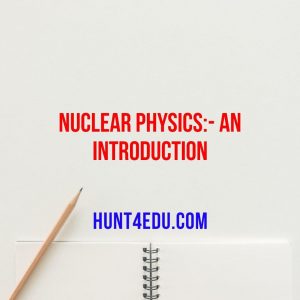Nuclear Physics:
Here, we provided Nuclear Physics:- An Introduction. Nuclear physics is the field of physics that studies atomic nuclei and their constituents and interactions. Other forms of nuclear matter are also studied. Nuclear physics should not be confused with atomic physics, which studies the atom as a whole, including its electrons. Free download PDF Nuclear Physics:- An Introduction.
 Discoveries in nuclear physics have led to applications in many fields. This includes nuclear power, nuclear weapons, nuclear medicine and magnetic resonance imaging, industrial and agricultural isotopes, ion implantation in materials engineering, and radiocarbon dating in geology and archaeology. Such applications are studied in the field of nuclear engineering. Free download PDF Nuclear Physics:- An Introduction.
Discoveries in nuclear physics have led to applications in many fields. This includes nuclear power, nuclear weapons, nuclear medicine and magnetic resonance imaging, industrial and agricultural isotopes, ion implantation in materials engineering, and radiocarbon dating in geology and archaeology. Such applications are studied in the field of nuclear engineering. Free download PDF Nuclear Physics:- An Introduction.
Particle physics evolved out of nuclear physics and the two fields are typically taught in close association. Nuclear astrophysics, the application of nuclear physics to astrophysics, is crucial in explaining the inner workings of stars and the origin of the chemical elements. Free download PDF Nuclear Physics:- An Introduction.
Nuclear physics is the field of Physics that studies atomic nuclei. In other words, nuclear physics deals with the components and structure of the nucleus. Nuclear reaction comprises the merging of nuclei, radioactive decay, fusion, fission, and the break-up of a nucleus. Free download PDF Nuclear Physics:- An Introduction.
BOOK INFO
BOOK NAME – NUCLEAR PHYSICS:- AN INTRODUCTION
AUTHOR – S B PATEL
SIZE – 78.76MB
PAGES – 371
Use of Nuclear Physics:
- The continuous research in the field of nuclear physics has helped us find various other uses. For example, we now have nuclear medicine, nuclear weapons and have even found its uses in geology and archaeology in terms of carbon dating.
- Atomic Physics An atom is made of a dense nucleus having neutrons and protons at the core surrounded by orbiting electrons as per the configuration. The center is positively charged and the surrounding cloud of electrons carries a negative charge. As a whole, the atoms in consideration can either be neutral or carry a charge (in this case we call them ions).
- In many places, you may have seen that atomic energy is the source of energy production in terms of nuclear fission and fusion. Let this not confuse you as they both are often used and associated together. The cutting difference between the two has already been started at the beginning of this article.
- Atomic physics concerns itself with the entire atom and how the electronic configuration of electrons can change. When an atom loses an electron, it becomes positively charged (cations) and when it gains an electron it becomes negatively charged (anions).
Law of Radioactivity;
- Radioactivity occurs due to the decay of the nucleus.
- External parameters such as temperature and pressure do not affect the rate of decay.
- Radioactivity is based on the law of conservation of charge.
- The daughter nuclei will have unique physical and chemical properties (that is different from parent nuclei).
- The decay rate of any radioactive material is directly proportional to the number of atoms present at that instant.
- α, β, and γ rays are followed during the radioactivity.
Units of Radioactivity;
There are two units of radioactivity and they are:
- Curie (Ci): If the radioactive substance decay at the rate of 3.7×1010 decays per second, then the unit used is Curie.
- Rutherford (rd): If the radioactive substance decay at the rate of 106 decays per second, then the unit is Rutherford.
Nature of Nuclear Force;
Nuclear physics is based on the forces known as nuclear force. The nature of nuclear force is given as:
- Nuclear forces are attractive in nature.
- These forces are independent of charges.
- The range of nuclear forces is short.
- As the distance between two nucleons reduces, the nuclear force becomes weak between them.
- The nuclear force is dependent on the spin.
SOURCE:- WHATSAPP
DISCLAIMER: HUNT4EDU.COM does no longer owns this book neither created nor scanned. We simply offer the hyperlink already to be had on the internet. If any manner it violates the law or has any troubles then kindly mail us or Contact Us for this(hyperlink removal).
We don’t aid piracy this duplicate grows to be supplied for university youngsters who’re financially bad but deserve greater to examine. Thank you.
READ MORE
Physics – An Infinite Resource
Mathematical Physics Problems:- Complete Guide For NET, GATE & JEST
Atomic & Molecular Physics for CSIR-UGC-NET/JRF/GATE
Mathematical Physics for CSIR-UGC-NET/JRF/GATE
Best Mathematical Physics For The Students Of BSc and MSc
Mathematical Physics Methods For All Entrance Exam By Fiziks Institute
